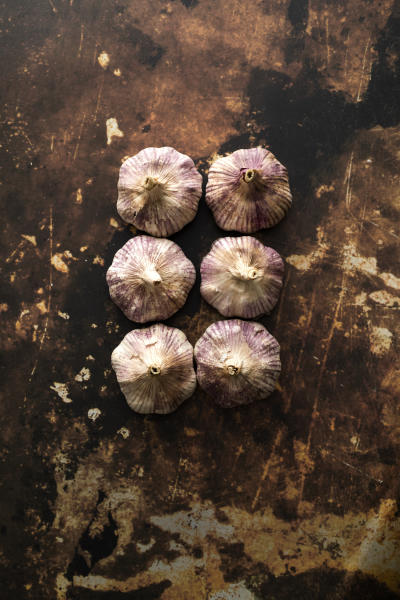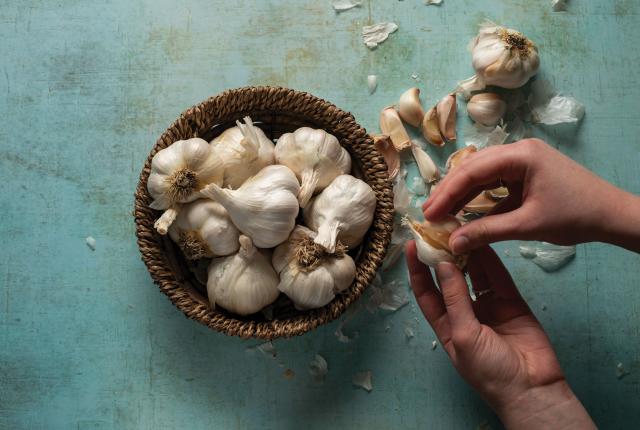Above: The bounty of the garlic harvest. Photographs by Douglas Merriam.
IN THE LATE 1970S, I was lent an apartment on Canyon Road in Santa Fe for a month, where I wrote the first draft of a satirical novel, whose complete title (hang on) is Some Instructions to My Wife Concerning the Upkeep of the House and Marriage, and to My Son and Daughter Concerning the Conduct of Their Childhood. The demented male chauvinist narrator was very proud of his pamphlets on gardening. Among them was “Garlic Questions Finally Answered.”
It turned out that this was a little joke I had unwittingly played on myself. By the end of the decade, I was a full-time farmer, and my largest crop was—guess what—garlic, which I sold at the Los Alamos and Santa Fe farmers’ markets. Where, of course, I ended up answering endless “garlic questions.” As I still do at the Saturday (and sometimes Tuesday) Santa Fe Farmers’ Market in the Railyard.
So, where to begin? First of all, New Mexico is an excellent place to grow garlic. The altitude still gives us cold winters most years, keeping down pressure from insects and diseases, a plague in warmer climates. One year way back when, grasshoppers nibbled at leaves, and another year a sharp-eyed entomologist pointed out the existence of thrips, which apparently were causing a little damage. Some gophers like garlic, but most seem not to. Pigs once got into a freshly planted field, but they were after the soybean meal I was using as fertilizer, not the garlic itself.
My advice? Plant away. Do it in the fall—September, October, November—before the ground freezes. Break each bulb into cloves and plant the cloves about six inches apart, two inches or so deep, in soil enriched with compost and/or manure. The spiciness of garlic comes from sulfur, and generally there should be enough of that element already in the soil, though the addition of a small amount in order to acidify our alkaline soils will serve to release other minerals. Keep it damp; don’t let the soil dry out.
The best way to obtain planting stock is from a local grower, who will have acclimatized the plant. Garlic is phototropic, meaning it is sensitive to day length, but it adapts fairly rapidly to changes. Garlic reproduces by cloning, not by sexual reproduction, meaning that the “varieties” are, in effect, landraces—cultivars that have adapted to the soil and water and climatic conditions of this or that particular area. The names of the cultivars are at best a clue to where they originated and usually not a solid fact. I grow Russian Red and Siberian and Turban Chengdu, cultivars I obtained from an Albuquerque grower; it’s unlikely that they can be directly traced back to the origins suggested by their names. With one exception, more or less: I also grow California Early (a strain I have renamed Bosque Early), or your common white supermarket garlic, grown in California for generations now. In any case, all garlic ultimately originated in the Caucasus.
 Above: Garlic Planting Steps. Create divots, fill with cloves, and lightly rake over them.
Above: Garlic Planting Steps. Create divots, fill with cloves, and lightly rake over them.
A common Garlic Question is: When and how do you harvest the plant? The when depends on the where, so there is no fixed rule. It also depends on the type of garlic you are growing. Grossly, there are two types: hardneck, which I also call top-setting, and softneck. Hardneck garlic sends up what you can call a stiff seed stalk, where a white scape gradually unfurls, swan-like. These are a common ingredient in Asian dishes, with a notable uptick in popularity here. If allowed to mature, the scape will develop into a round casing about an inch in diameter, housing countless teardrop-shaped bulblets (or bulbils) with mauve skin. These are cloned material, in effect tiny garlics ranging from the size of a grain of wheat to a small kernel of corn. After years of dumping them into the compost pile, we realized they are actually quite useful in the kitchen when you need only a small amount of garlic and don’t want to go through peeling a whole clove. Bulblets—unpeeled, as the skin is quite thin—can be thrown into soups, salads, or guacamole or sprinkled on pizza. (Garlic is, by the way, known for its antibiotic properties; I swallow a few bulblets every morning for vague medicinal purposes.)
But back to harvest. Most softneck types will be ready first. At the latitude of northern New Mexico, this will occur roughly in mid-June. The keen of eye will notice a very faint yellowing in the leaves when the plant has finished its work of storing up energy in the bulb. Easier is to count the bottom “wrapper” leaves. When four to six have turned brown and shriveled up, it’s time to dig up the plant. Unsure? Dig it up and see if the clove divisions are well marked. If so, it’s ready to pluck—and to eat. To extend its usefulness, you can dry it, but be warned: New Mexico skies are too clear to dry garlic outdoors in direct sunlight. A shaded porch or garage will do fine. The plant dries through the leaves, so don’t stack plants in a big pile without some spacing between the leaves.
Hardneck or top-setting types will mature later, sometimes as much as two or three weeks later. Many and perhaps most growers cut off the scapes just after they emerge, in the belief that you get a larger bulb that way, though this is a matter of dispute. I let the scapes mature, in part because we bind up the bulbs around the stiff stalks for decorative kitchen bunches. And also because we have discovered that we can sell the bulblets. The scapes go on to mature fully after we harvest, pulling the last of the moisture and nutrients out of the stalk and leaves as the plant cures. We dig the bulbs just as the scape is about to straighten up from the position where it resembles a shepherd’s crook. Best not to trim the bulbs from the leaves and stalks until they are fully dry—usually within a couple of weeks—though you can eat your garlic at any time. Leaving either type of garlic in the ground too long will give you a bulb whose outer skin has turned black with mold (unattractive but still edible with the moldy skin washed off) or a bulb that breaks apart as you try to lift it.
The next-to-last question is: How long will it keep? In my experience, California Early and some other softnecks seem to store better than hardneck types, but, lacking a proper cold-storage facility, such as a walk-in cooler, I can’t give a firm answer. Besides, we’ve either planted or sold our harvest by fall. While you don’t need to do anything special in summer to early fall, after that it stores best in cold conditions, near freezing, and after January you would do well to keep it in a paper bag in your refrigerator. Or peel and chop and freeze it, though freezing will increase its pungency.
On the question of vampires, which garlic allegedly repels, I can give no conclusive answer. The jury is still out. A long, if tentative, answer, however, can be found in my forthcoming account The Garlic Papers: A Small Garlic Farm in an Age of Global Vampires, to be released by Santa Fe’s own Leaf Storm Press in October.

PANTRY

The Baddest Garlic In Town: You Can't Fight Genetics
My grandfather was known to snack on entire cloves of garlic. His Italian blood, I guess. Something got passed on, because hardly a meal goes by where I don’t dump an entire roughly chopped head of the stuff into whatever I’m cooking. The recipe calls for two cloves? Quadruple it. Hey, there’s power in that pungent, translucent bite. Of course, no cultivar has more flavor than the big, bold Russian Reds. That’s the garlic with the beautiful, flaky purple skin. Its cloves are a bit larger, which means less peeling. And less peeling means more garlic. Grandpa would be proud. —John Clary Davies


